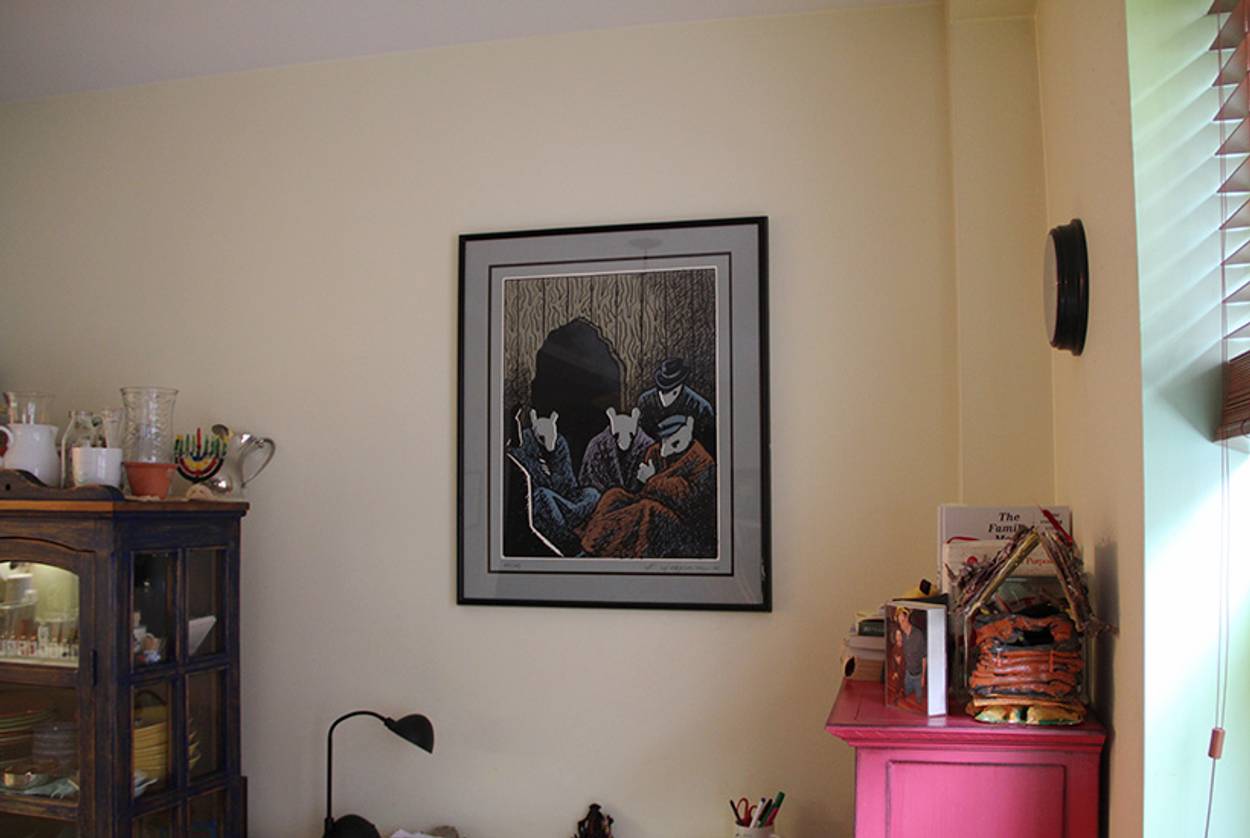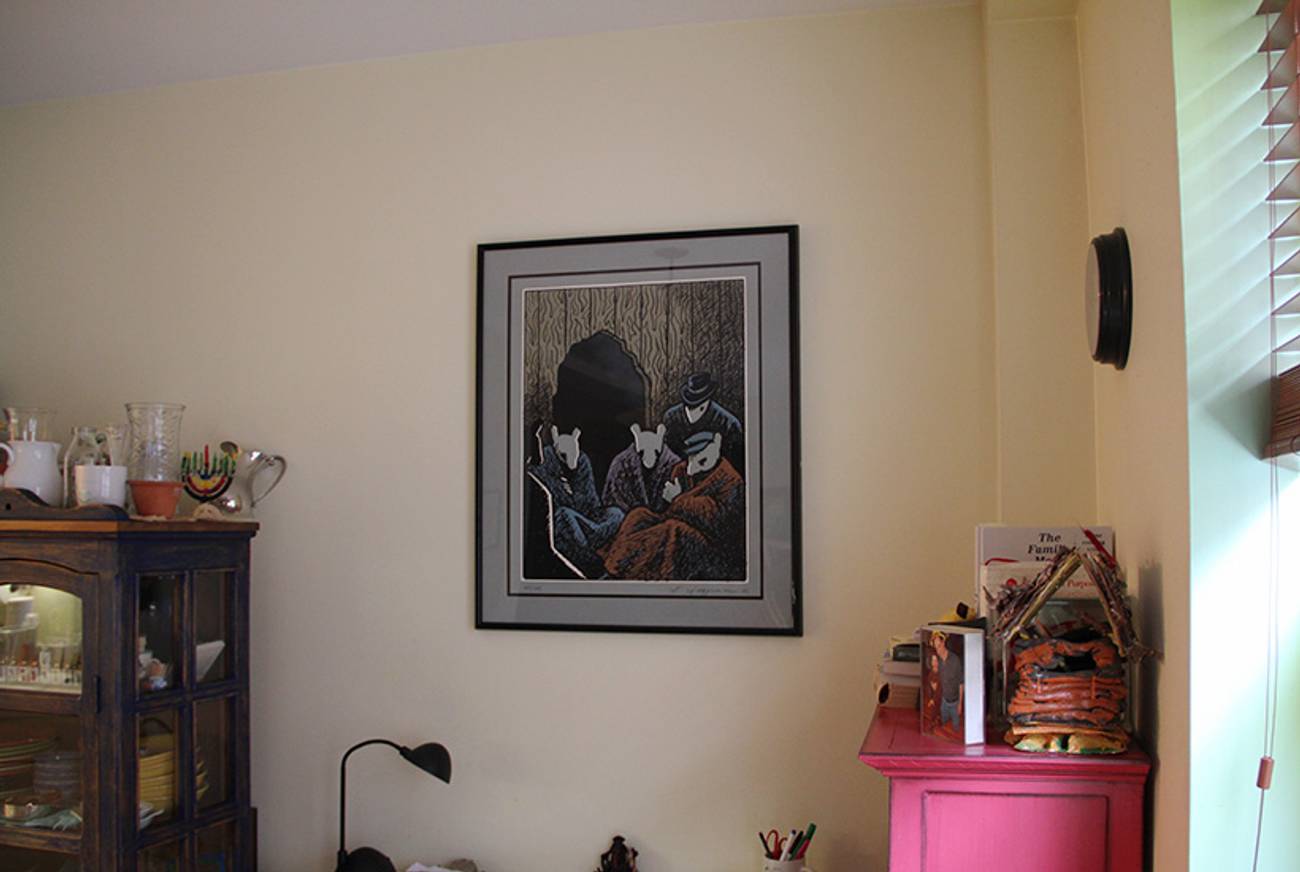A Maus in My House—Or, How To Teach Your Kids About the Holocaust
My Art Spiegelman print was suddenly worth thousands of dollars. But perhaps it was worth more hanging on my son’s wall.




My family paid a visit recently to New York’s Jewish Museum to take in the exhibit “Art Spiegelman’s Co-Mix: A Retrospective.” It was just as good as I expected: I believe that Spiegelman’s Maus, laid out page by page along several walls of the museum, is one of the last century’s great memorials, and the rest of his work proves how exhilarating even commercial art can be when the artist is smart and angry enough.
But I was not merely a disinterested observer.
By this, I am not referring to the death of someone in my family in the Holocaust, because although family members did die, they were distant cousins: My father got out of Germany in 1936 and my grandparents in 1939. It seemed to me that we had merely been brushed lightly by a black wing. Although my father must have mentioned the Holocaust at some point, I can’t remember getting a complete narrative from him. I do remember being offended when a girl in my seventh-grade social studies class whom I’ll call Sarah Sayer made a little death camp out of sugar cubes. I was not interested in any kind of reckoning. I kicked the psychological can down the road.
Pretty far down. I was an English and German major in college. In 1980 I moved to Germany for a year and a half. I never brought up the Holocaust there, and nobody broached it to me—people were unfailingly welcoming and friendly. It was only when I had come home to work in journalism that I allowed myself some curiosity and horror. I did a brief run of stories addressing the topic in one way or another.
This led me to Spiegelman. In 1986, after he had published the first volume of Maus, I wrote a profile in People magazine titled “Art Spiegelman Battles the Holocaust’s Demons—and His Own—in an Epic Cat-and-Mouse Comic Book.” It was a wonderful experience for me. I liked Art very much. He was a perfect subject: possessed, neurotic, brilliant, witty. I felt I was supporting (or at least piling onto) something important. Art had a cat that fetched and a wife who was with child—both enviably exotic at that point in my life. He seemed to enjoy me as well: He presented me with a screen print. It portrayed four “mice” huddled miserably in front of a large arch-shaped hole in a huge wall, beyond which was Art’s Poland, and death.
***
Twenty-seven years have passed. Art went on to merit his Pulitzer Prize and museum retrospectives, and I became religion writer for Time magazine, before leaving a few years ago to work on a book about the psalms. We stayed in touch briefly. But soon he was just a public figure again. I occasionally wondered whether some production of mine would live up to his artistic and political standards, and usually decided not.
I kept the print, of course. I framed it conscientiously with UV-resistant glass, and it traveled with me from apartment to apartment. I was proud of it; after I left People I didn’t meet as many of my artistic idols. In fact, one of the twice-removed relatives my family did lose in the Holocaust, named Carry van Biema, had been a promising young artist. In the 1990s a former patron of hers who was dying located me and bequeathed me a lovely sketch by her of a frail-looking young girl. When I had enough money to buy rather than rent, I hung it next to the Spiegelman—a regular Wall of Remembrance.
A few years later, I took them down. I recognized that I was something of a depressive, and I figured I could find something cheerier to survey each day. I had long ago finished, or thought I had finished, my Holocaust phase. I also admitted to myself that artistically, I didn’t like the Spiegelman that much. It had plenty of gravitas, I thought, but lacked Maus’ pitiless forward momentum. I put Carry van Biema in a closet and Art Spiegelman behind a dresser and replaced them with a shelf of colorful little dioramas from Peru featuring happy miniature peasants and the Holy Family. Every once in a while I felt twinges of guilt, but on the balance I was probably a tiny bit happier than before. At some point the glass on the Spiegelman developed a crack, and I would have had to repair the frame to hang it again. I didn’t.
Then one day an article appeared in the paper anticipating the Jewish Museum retrospective. It startled me. The Art interviewed in the story sounded a lot like the Art I had interviewed, and I was sorry the relationship hadn’t bloomed. And of course I felt guilty again about the print.
But then I achieved a moment of clarity. Why was I holding onto it? The mice huddled behind the wall were doing me no good huddled behind my bureau. What would a Spiegelman screen print, edition of 125, be worth? Five hundred dollars? A thousand? Whatever the figure, I was pretty sure that the museum retrospective would drive it up. But there were some issues. I hadn’t paid anything for it. Should I donate the proceeds to a Holocaust reparations group, or to a Spiegelman-acceptable political cause? And if I simply went for the money, how could I deal it discreetly? Was there a way to do it without Art somehow finding out?
I pulled back the bureau and slid out the print again. It had not changed. Somehow, I would de-accession it.
At that very moment my 11-year-old son chanced by. What’s that, he asked? I gave him the short answer—the mice in the drawing stood for Jews during the Holocaust. “I’d like that in my room,” he said.
This was unexpected. His taste thus far had run to photos of animals and the poster for an animated film. I wondered: Did he know what he was asking for? I believed I had given him the 6-year-old Holocaust talk. But nothing since, that I could recall. I had kicked it down the road. Should I lay the tween edition on him now? What had he learned in school, either from his teachers or from some Sarah Sayer equivalent?
Before I figured it out, he said, “Don’t worry, Dad. I come from a different generation. I have different feelings than you do.”
“It’s yours,” I said. He must know something, but what? I decided to let it be. “This would be your first art by a real artist. You’ll have to be very, very careful with it.”
“I will,” he promised. Now all I had to do was find a new everything-resistant frame.
And one more thing. We needed to go to the retrospective.
My son turned out to be a very hard sell. “I like the way he draws, but I don’t like what he draws about,” he said. This either meant he had a far more sophisticated understanding than I had guessed or just was not ready at all. I told him we were going.
When we arrived, I handed him off to my wife. Much later I asked whether they had walked the Maus walls. “Oh, yes,” she said. “We had a discussion about it.” How did that go? “Oh, he had a few small questions, but that was pretty much it.”
Meanwhile I made my own way through. I found myself drawn to a large sheet featuring two gigantic prone figures, one with a moneybag for a head and the other with a laurel wreath and a short skirt, surrounded by classic comic characters from Krazy Kat to Popeye to Dick Tracy, with the legend “The Bastard Offspring of Art and Commerce murder their parents and go off on a Sunday Outing.” So, if I’d sold it, perhaps Art would have understood. I was also somewhat shocked to see that the print we had at home was not a one-off, but a large color rendition of a full-page illustration (“Mouse Holes”) in Maus. It was static because it was a chapter frontispiece. I thought, “That would knock the price up.”
Indeed. My last stop was at the museum gift shop. There they were selling Spiegelman screen prints. Including one from my run. I asked a saleswoman how much they cost. She pointed to mine. “Well, that one is $4,700.” Correctly assessing my level of disposable income, she added sympathetically, “It’s what his studio agreed was a fair price.”
I cannot really shake the figure from my head. I am happy to say that I didn’t immediately wrest the print from my son’s hands and flog it outside the Jewish Museum. What I did think was that he should have it. And maybe when he goes to college, if he needs some extra money, he can sell it.
The law of scarcity versus the public attention span. The original survivors and refugees are now almost gone. What will their images—in comics or video or any other form—be worth to people in 2020? That’s funny, I thought. I’m dabbling in Maus futures. Then I thought: not so funny. I’m dabbling in Holocaust futures.
Or my son will. Maybe, when the time comes, he’ll decide not to sell. My hope is that whatever the Holocaust may mean by then, he’ll know enough about it to assess its trajectory. For Hanukkah this year, we gave him a copy of the first volume of Maus.
***
Like this article? Sign up for our Daily Digest to get Tablet Magazine’s new content in your inbox each morning.
David Van Biema is writing a book about the psalms for Simon & Schuster.
David Van Biema is writing a book about the psalms for Simon & Schuster.